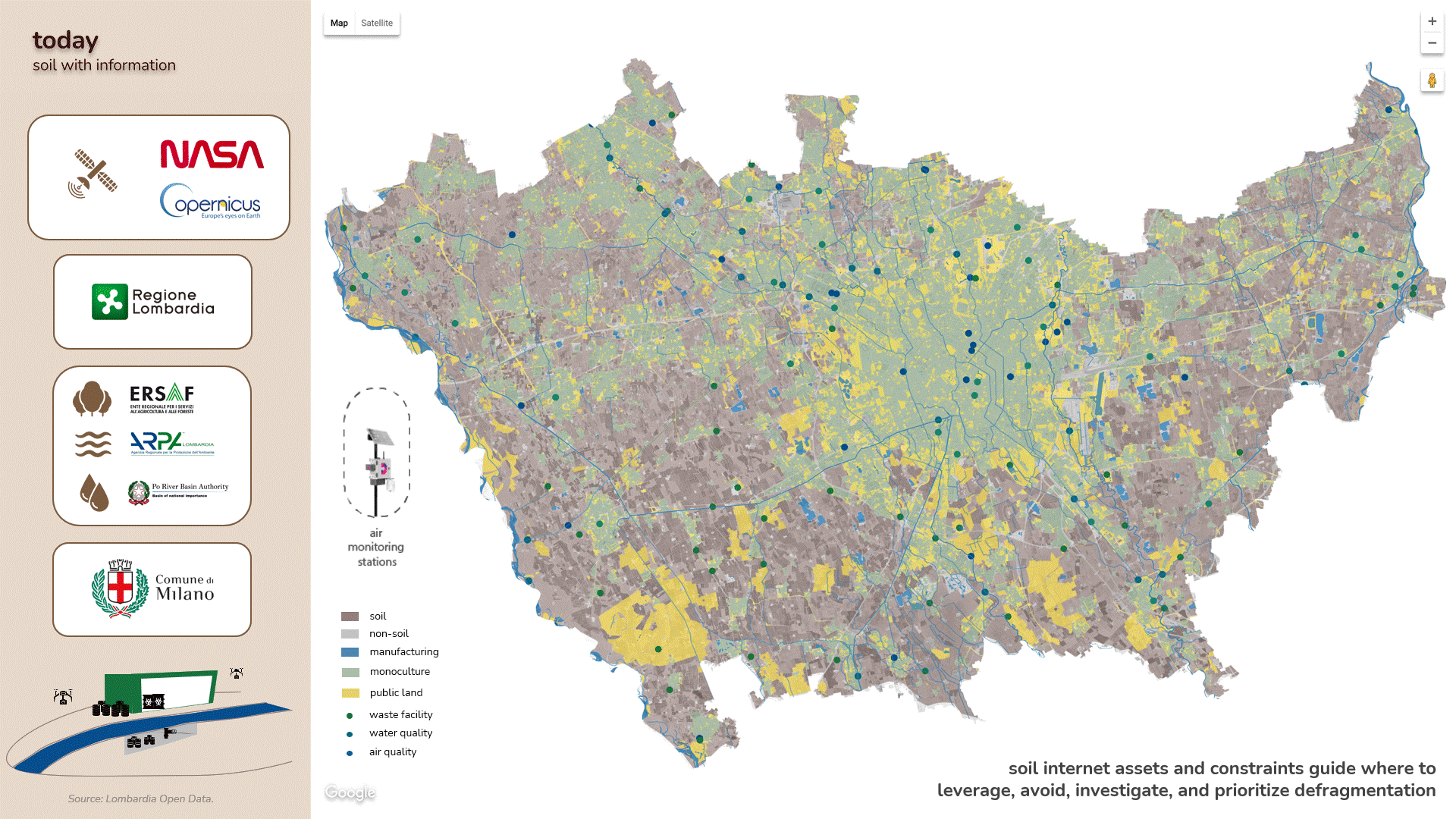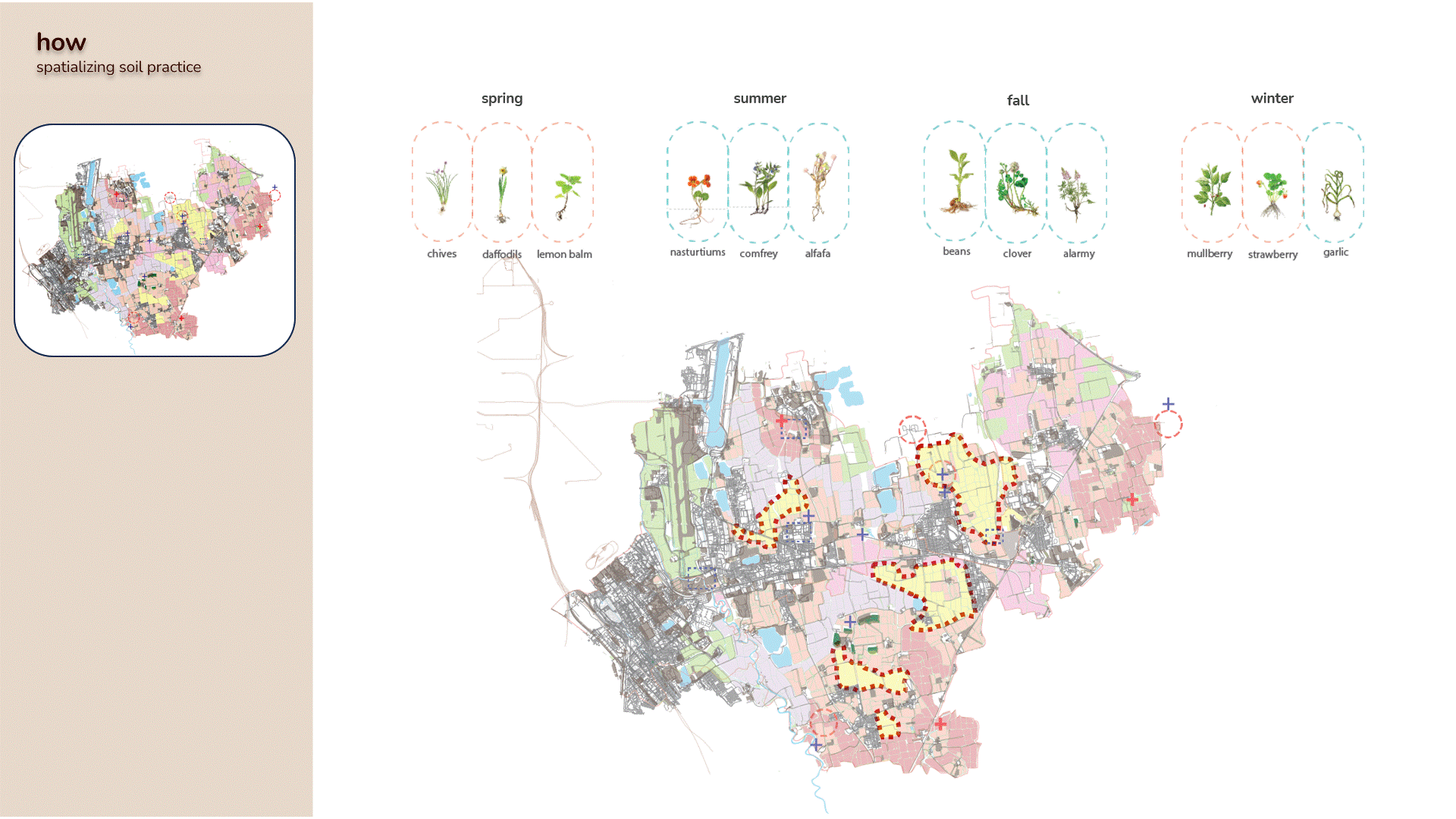Introduction
Milan, Northern Italy’s epicenter, confronts economic and environmental challenges rooted in a shift from agriculture to manufacturing. To secure its future, Milan invests in knowledge, tourism, and place-based innovation, relying on revenue from high-income foreigners, students, and the European Union. Strategic efforts to transition to a green economy focus on renewable energy, waste reduction, and local provision of demanded resources. However, goals to preserve biodiversity, remediate contamination, and improve air quality have not realized a return on investment in land value.
As Europe’s most air-polluted city, Milan acknowledges its climate challenges and has worked to understand and change its conditions. The potential to transform current soil management practices lies in addressing its historic monoculture and utilizing its possible arable land. To ensure a diverse circular and economic future, Milan must employ a suite of solutions.This includes using polycultures for diverse soil conditions, reaching residents through media, and convincing investors through evidence of diversification, profitability, and reliability. Milan can also expand its innovation by tapping into the skills of craftsmen in fashion, construction, and food industries.
Coltura serves as a tool to empower Milan’s residents to restore its soil. This tool is designed for site-specific analysis and offers a guided soil understanding and prescriptions. Potential users, bear dissimilar needs, requiring a flexible approach. To find solutions, users first self-identify by type, then search for their land of interest, and finally select the nature-based and structural solutions able to meet their diagnosed needs. Through market-based engagement, Coltura aims to channel knowledge and land assets into political goals and economic opportunities.

Potential Users
Users have varied needs based on the types of spaces they operate, their goals, and their personal preferences. The polyculture that may be supported is dependent on
- The seedability of the surface. Seedable surfaces have varied soil conditions that vary by the inch while non-seedable surfaces must create new ground and operate in largely controlled conditions.
- The goals of the user. Goals may be oriented towards better soil for human, animal, or soil needs. Humans need soil to produce crops for consumption, profit, research, education, and climate quality. Animals need soil to support fodder, shelter, and pollination. Soil needs solutions that provide nutrients, filter contaminants, and preserve biodiversity.

The Farmer
- The Farmer: may overhaul their rotational strategy operated on uncontrolled open fields of agricultural land. Large cereal producers and smaller cascinas can transition from fallow or stressed land to a seasonal polyculture that realizes economic profit by entering new industries. Fertilizers and plows have left nitrogen, phosphorus, and sodium scars that can be healed over time through first identifying, then meeting needs.
- The Researcher: Researchers may tap crops with potential to test in controlled or uncontrolled settings and choose a contained, diversified selection of crops. With the Polytechnic and University of Milan leading Italy’s soil research efforts and with existing partnerships at publicly-supported innovation hubs, research universities may continue to purchase possible arable land and populate it with polycultures with potential for alternative uses.
The Gardener
- The Homeowner: Residents with soil operate on smaller open plots and may realize a polyculture that bears food for consumption, aesthetic, or climate needs. Residents also may estimate their carbon sequestration to earn profit and support local goals.
- The City Dweller: Subject to the worst air quality conditions in the province, urbanites may meet their climate and aesthetic goals through roof or balcony gardens. Milan has identified over 6,500 roofs that may serve as urban gardens and have supported the harvesting of 280 to date.
The Organizer
Community leaders may not have land but seek to leverage free-lease ownership or public land to build a stock of resources for their collective. Likely in open fields on possible arable land, communities may select polycultures that provide food, recreation, or wealth via profit.
The Admirer
Admirers are residents or tourists visiting agriculture for recreation and admiration extends to agriculture when users are engaged in the land and its supported activities. Tourists often prefer low grasses and shaded areas provided by vineyards, orchards, and fields of herbs.
Policy
Milan’s layered policy protections limit the agricultural use of 65% of its soil. That said, much of the protected land is farmed and supported with with funding for projects that increase biodiversity and bear light-touch anthropogenic uses such as energy production, carbon capture, and recreation. Proprietors may access deep funding pools from the EU, Italy, Lombardy, and the City of Milan. Milan’s political capital is spent on advancing their climate positive objectives centered industries of focus: food, fashion, and construction. Plans touted by local government revealed preference for construction industry advancement. Reaching climate goals for air quality and carbon reduction relies on innovation of networks that access use o private land. Holes in ecological networks can be patched by reorienting the agricultural land use of private land owners.
Network analysis of animals traversing the province originating from reserves revealed the disappearance of the central river band that runs through the east of the City of Milan. Ecological connection may be driven by investing in possible arable land to the south of the city. Policy protections will drive economic feasibility of potential investments in climate.

Economy
Comparative economic analysis of industries with similar populations and in nearby localities suggest industries of investment and pride. Mapping of innovation nodes, industry retail and warehouse aggregations, and meeting places.
- Fashion is the historic industry of Milan, signified by its capital status and biannual fashion weeks. Raw materials for fashion production have maintained long supply chains since textile manufacturers were edged out by East Asian producers.
- Food is the lifeblood and focus of Milan. The majority of Milan’s circular economic efforts have tightened and collated local supply chains.
- Construction is Milan’s new innovation marker. Projects touting vertical forests, carbon zero and negative construction and operations, and green corridors are scattered about central and north urban Milan. To continue leading sustainability in construction, Milan may yield polycultures that manufacture carbon-negative materials.
Use cases for crops with circular economic value may adjust local priorities and calibrate planting recommendations to rotate in local needs.

Methodology: Site Selection
- Finding your Site:
- Users with existing land self identify their location by typing in their address.
- Users prospecting for land or to experience land filter property by geography, availability, and interest. The availability of seeable land for production is determined by its agricultural value, land use, overlaying protections, tenure.
- Diagnosing your Site: Users select their site to understand the soil conditions they face as owners, potential owners, or visitors. Measurement of soil qualities, including the natural landscape, lithography, depth, nitrogen vulnerability, the concentration of soil organic carbon at varied depths, soil bulk density, and agricultural value deduce the polyculture the land may support.
- Building your Site: Users select the base crops for their polyculture. Solutions are filterable by soil conditions and user goals for ease, profit, and carbon capture.


Prototype: Corridor
- Site selection was driven by the deduction of public priorities, gaps in the ecological network, and circular economic product needs. The small farmer, cascina owner, searching for a new spatial strategy searched for future circular economic crops demanded in industries of pride.
- Public priorities include environmental protections that both constrain the use of land and afford access to funding pools dedicated to ecosystem service provision. Priorities may also support economic objectives to innovate on practices and potential products.
- Gaps in the ecological network may be filled by strengthening connectivity of existing arable land.
- Circular economic needs are To ensure user needs were met by the product, we test drove its use for a farmer (cascina) intending to support the future circular economy of Milan. Hemp, flax, and silk were selected for their circular and versatile use in food, fashion, and construction industries, their compatibility with the temperate broadleaf forest biome, their nativity in Milan, and their climate and economic value. Compatibility was located by concatenating soil type, agricultural value, and seedability.
A solutions catalog, covering both crops and structural solutions (nature-based and non-nature-based), was created for Milan’s diverse soil types—sealed surfaces, possible arable land, current agricultural land, and wild land. Crop choices were made based on compatibility with existing cereal crops, historical cultivation, soil characteristics, and potential use in food, fashion, and construction. Hemp, mulberry, and flax emerged as key cash crops. Planning a crop rotation sequence is crucial in agriculture, considering crop families, nutrient needs, and pest/disease cycles. This involves assessing goals and resources, identifying crop families, and planning the rotation sequence.
Crops were categorized and distributed spatially based on soil requirements:
- Cash crops near research facilities and innovation centers
- Food Forests near residential areas
- Fruit Trees around priority biodiversity areas and transportation routes
- Flowering Plants near water bodies and potential recreational zones
- Phytoremediation Crops near manufacturing plants to assist with contamination.
Intercropping Spatial Strategy – Farmers plant two or more crops in the same field allowing them to harness various advantages by strategically combining crops with different root systems, supporting roles, and growth habits.

Conclusion
Coltura is a flexible tool developed for Milan but applicable to any geography with robust soil data. Relevant solution types depend on environmental conditions. Lungs, filtering air, and networks, allowing for coordination, were needed to systematically address air quality conditions. Sponges, retaining water, are necessary for projects resolving flooding and water filtration challenges.
Industries and crops relevant for farmers to bear are market-dependent. Factors for crop selection include nativity, local and national consumption and production demand, and provision of needed ecosystem services.
The global climate movement has and will continue to develop B2B and B2C markets for ecosystem services. This increased demand may be captured through the development of a tool that guides informed selection of polycultures that meet aligned ecosystem and consumer needs. Examples of synergies include:
- Consumer interest in gardening with urban roof garden incentives.
- Public engagement of residents in site-specific projects with networks that support climate goals and pool private interest capital.
- Private need for carbon offsets with farmers and other holders of large land assets willing to shift to no-till farming with fallow periods.
Informational feedback loops accessed through surveys progress reports and, a community forum can align local production with industry needs.
- Designers may identify sustainable fabrics with long supply chains.
- Restaurants may report native ingredients with high import volumes to identify excess local demand.
- Builders may identify materials ideal to meet carbon capture goals.
In summary, there is a market to be created to coordinate soil potential and soil use at all scales of settlement. A market for horticulture can be nudged to align with climate and economic goals with research into suitability, ecosystem service needs, and local demand.

